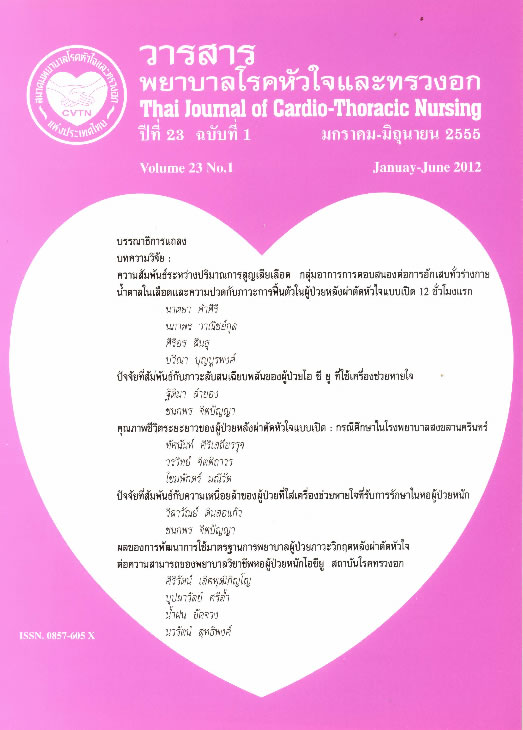ปัจจัยที่สัมพันธ์กับความเหนื่อยล้าของผู้ป่วยที่ใส่เครื่องช่วยหายใจที่รับการรักษาในหอผู้ป่วยหนัก
Keywords:
ความเหนื่อยล้า, ผู้ป่วยที่ใส่เครื่องช่วยหายใจ, ระยะเวลาของการใส่เครื่องช่วยหายใจ, ภาวะซึมเศร้า, คุณภาพการนอนหลับ, Fatigue, Mechanically ventilator patients, Ventilator time, Depression, Sleep qualityAbstract
บทคัดย่อ
การวิจัยครั้งนี้เป็นการวิจัยเชิงบรรยายมีวัตถุประสงค์เพื่อศึกษาความสัมพันธ์ระหว่างปัจจัยคัดสรรจากกรอบแนวคิดของไปเปอร์ ได้แก่ ระดับอัลบูมิน ระดับฮีโมโกลบิน ระยะเวลาของการใส่เครื่องช่วยหายใจ ภาวะซึมเศร้า กับความเหนื่อยล้าของผู้ป่วยที่ใส่เครื่องช่วยหายใจที่รับการรักษาในหอผู้ป่วยหนัก โรงพยาบาลศูนย์ ได้แก่ โรงพยาบาลลำปาง โรงพยาบาลพุทธชินราชพิษณุโลก และโรงพยาบาลอุตรดิตถ์ กลุ่มตัวอย่างคือผู้ป่วยที่ใส่เครื่องช่วยหายใจที่รับการรักษาในหอผู้ป่วยหนักจำนวน 100 คน ที่ได้จากการเลือกแบบเจาะจงตามคุณสมบัติที่กำหนด เครื่องมือที่ใช้ในการวิจัยประกอบด้วย แบบบันทึกข้อมูลส่วนบุคคลทั่วไป แบบบันทึกข้อมูลเกี่ยวกับการรักษาและความเจ็บป่วย แบบประเมินคุณภาพการนอนหลับของ เวอแรนและสไนเดอร์-ฮาเพิร์น (The Verran and Synder-Halpern sleep scale: VSH sleep scale ) แบบประเมินภาวะซึมเศร้า (Center for Epidemiologic Studies-Depression Scale: CESD ) และแบบประเมินความเหนื่อยล้า ของไปเปอร์ (Piper Fatigue Scale) วิเคราะห์ข้อมูลโดยใช้ค่าสัมประสิทธิ์สหสัมพันธ์ของเพียร์สัน
ผลการวิจัยพบว่าความเหนื่อยล้าของผู้ป่วยที่ใส่เครื่องช่วยหายใจที่เข้ารับการรักษาในหอผู้ป่วยหนักอยู่ในระดับปานกลาง (=5.19, S.D.=2.59) คุณภาพการนอนหลับมีความสัมพันธ์ทางลบกับความเหนื่อยล้าของผู้ป่วยที่ใส่เครื่องช่วยหายใจที่เข้ารับการรักษาในหอผู้ป่วยหนักอย่างมีนัยส้าคัญทางสถิติที่ระดับ.05 (r=-.393) ส่วนระดับอัลบูมิน ระดับฮีโมโกลบิน ระยะเวลาของการใส่เครื่องช่วยหายใจและภาวะซึมเศร้าไม่มีความสัมพันธ์กับความเหนื่อยล้าของผู้ป่วยใส่เครื่องช่วยหายใจที่เข้ารับการรักษาในหอผู้ป่วยหนักอย่างมีนัยสำคัญทางสถิติ
ผลการวิจัยนี้สามารถนำมาเป็นข้อมูลส้าหรับการพัฒนาโปรแกรมการบ้าบัดทางการพยาบาล เพื่อให้การพยาบาลบำบัดความเหนื่อยล้าในผู้ป่วยที่ใส่เครื่องช่วยหายใจที่เข้ารับการรักษาในหอผู้ป่วยหนัก
คำสำคัญ : ความเหนื่อยล้า, ผู้ป่วยที่ใส่เครื่องช่วยหายใจ, ระยะเวลาของการใส่เครื่องช่วยหายใจ, ภาวะซึมเศร้า, คุณภาพการนอนหลับ
Abstract
The purpose of this study was to examine fatigue in mechanically ventilated patients and the relationships among fatigue and selected factors such as albumin, hemoglobin, ventilation time, quality of sleep, and depression in mechanically ventilated patients admitted in intensive care units (ICU). The study sample consists of 100 mechanically ventilated patients admitted in ICU from three northern tertiary care hospitals selected by a purposive sampling based on inclusion criteria. The instruments included a demographic data form and illness, the Verran and Synder-Halpern sleep scale, the Center for Epidemiologic Studies-Depression Scale (CESD), and Piper Fatigue Scale. Statistical techniques used in data analysis were frequency, percentage, mean, standard deviation, and Pearson product moment correlation.
The results of this study showed that fatigue scores of the patients with mechanical ventilators admitted in an intensive care unit were at the medium level. ( = 5.19, S.D. = 2.59). There was negatively statistical correlation between sleep quality and fatigue in patients with mechanical ventilators admitted in an intensive care unit at the level of .05. (r = -.393). However, there were no statistical correlation between albumin, hemoglobin, ventilator times, depression, and fatigue in patients with mechanical ventilators admitted in an intensive care unit at the level of .05.
Recommendation: The evidence of this study should be applied to develop nursing therapeutic programs to reduce fatigue in mechanically ventilated patients admitted in ICU.
Keywords : Fatigue, Mechanically ventilator patients, Ventilator time, Depression, Sleep quality
Downloads
How to Cite
Issue
Section
License
บทความนี้ยังไม่เคยตีพิมพ์หรืออยู่ในระหว่างส่งไปตีพิมพ์ในวารสารอื่น ๆ มาก่อน และกองบรรณาธิการขอสงวนสิทธิ์ในการตรวจทาน และแก้ไขต้นฉบับตามเกณฑ์ของวารสาร ในกรณีที่เรื่องของท่านได้ได้รับการตีพิมพ์ในวารสารฉบับนี้ถือว่าเป็น ลิขสิทธิ์ของวารสารพยาบาลโรคหัวใจและทรวงอก






